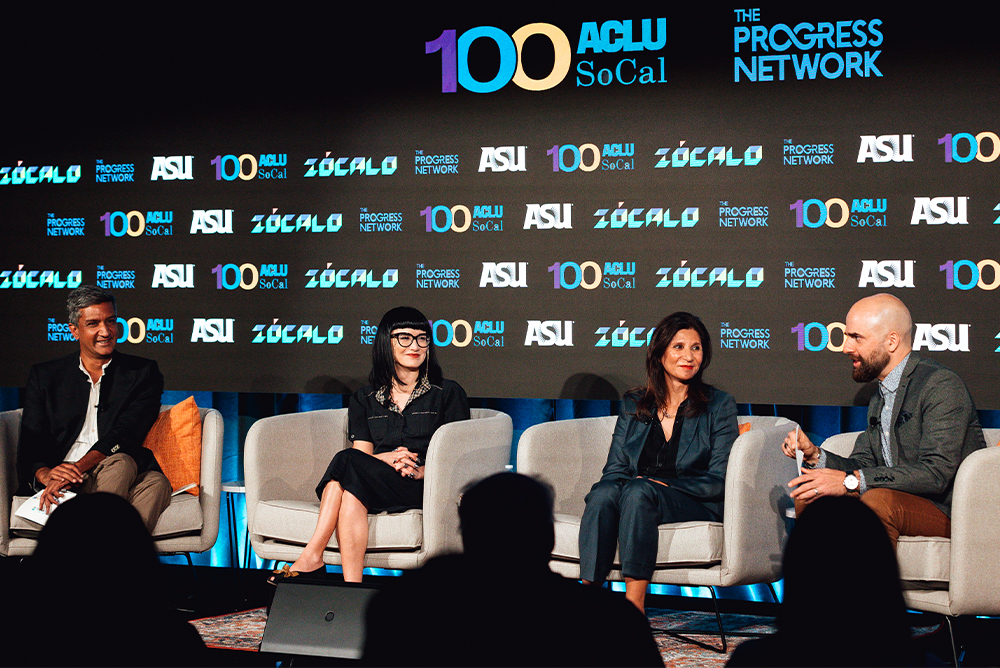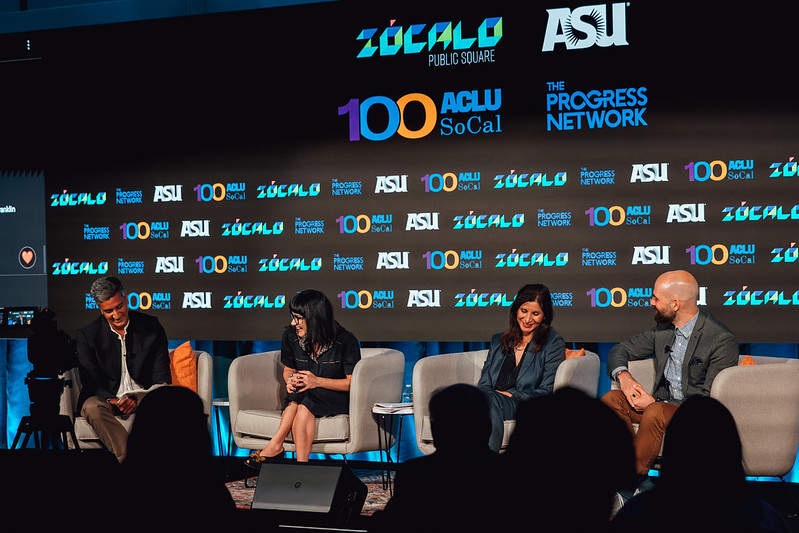
From left to right: Ramesh Srinivasan, Mashinka Firunts Hakopian, Faiza Patel, and Mohammad Tajsar.
“Can surveillance be a necessary evil?”
The question came near the end of yesterday’s public program, “What Is the State of Surveillance?,” held at the ASU California Center in the historic Herald-Examiner building in downtown Los Angeles.
The Zócalo panel, presented in partnership with ACLU of Southern California and The Progress Network, had already reviewed a longstanding history of surveillance as a mechanism of control, and had mulled ways people can push back against an Orwellian present. Now, during the audience Q&A, someone wanted the panelists to comment on what surveillance was good for.
“Certainly, it can be useful if you’re the government and want to end crime,” said Mohammed Tajsar, staff attorney for ACLU SoCal. But the important question is whether it is necessary. And to that end, he said, “I have not seen empirical data that suggests that surveillance ends up giving us positive public safety outcomes. There’s simply no evidence to suggest that.”
Moderated by tech and society scholar Ramesh Srinivasan, panelists, again and again, spoke about surveillance’s societal costs, and pushed back against the assumption that more is better when it comes to information.
The panelists began the conversation by tracing the ways the state and private sector in the United States have found to keep tabs on people and gather personal data.
Tajsar went back to the origins of the U.S., speaking about the ways surveillance was first used to control enslaved and indentured people, and about how it was wielded by “keepers” of 1800s-era government-run poorhouses—people designated to watch poor people. The New Deal and its creation of the modern welfare state, he argued, “cemented the state as surveiller of poor people.”
All of these past efforts helped create our modern surveillance state, said art and technology scholar Mashinka Firunts Hakopian—only now methods are “automated and implemented in a scale that is unfathomable.” Hakopian cited Dark Matters: On the Surveillance of Blackness, where author Simone Brown makes the case that today’s biometric recognition can be traced back to the ways slave owners branded the people they enslaved. She also mentioned Virginia Eubanks’Automating Inequality: How High-Tech Tools Profile, Police, and Punish the Poor—a book that shows how the modern algorithmic models used to determine who gets social security benefits bring the poorhouse keeper model “into the digital space.”
Authorities have historically used surveillance to suppress dissent, observed Brennan Center government surveillance expert Faiza Patel, the final panelist of the night. “This can be seen, most recently, in racial justice protests around the country after the killing of George Floyd,” she said. During protests, Patel explained, police collected social media data—to figure out who people at the protests were, and who they were connected to—and deployed drones overhead. “It shows you interoperability and the fusion of data and functions, which is something we see a lot of,” she said.
Hakopian, who is originally from Yerevan, Armenia, shared that the methods Patel described were “front of mind” for her. “I know we’re gathered here today to discuss surveillance in the local U.S. context, but today, just a few hours ago, as there’s been a violent ethnic cleansing unfolding in the Republic of Artsakh targeting Armenians, in Azerbaijan, the activists who have been speaking about this have been targeted and jailed” she said, referencing an Amnesty International post she’d just seen about this.
“What are some of the things we start doing about the status quo instead of feeling perpetually anxious?” Srinivasan, the moderator, asked the panel.
There are a lot of things we can do to protect our digital hygiene, Patel said. These can be very simple: When a website asks if you want to accept all its cookies, scroll down and uncheck them, she suggested. “That’ll make it a little harder to collect your information, so why not?” Using a VPN also “signals to companies that we value our privacy and we don’t want to be tracked across the internet.”
And get involved, Patel advised. “If you see something going on, or you read about it in the newspaper, write to your congressperson and express your concern.” That has a real impact, she said. Patel works with Sen. Gary Peters from Michigan, who is very concerned about the Terrorist Screening Database (TSDB), the consolidated database about people known or “reasonably suspected” to be or to have been engaged in terrorism or terrorist activities. “He gets pressure at home” from his constituents, she said, “which then translates to interest at the congressional level, which, maybe, will translate into an opening for some changes into the way the TSDB is structured.”
“For me, the most interesting and frankly hopeful place of resistance to surveillance is deeply grassroots local organizing that I’ve seen in Southern California and across the country,” said Tajsar. “More than just showing up to city councils. Actively opposing every single surveillance program and demanding a fundamental dismantling of this architecture.”
Artists and activists can also help us, Hakopian said. “Something we can glean from the cultural sphere is how to visualize not only those processes of surveillance but how to visualize ways to respond and redress these processes.”
During the Q&A session, people in the audience at the Herald-Examiner and online via a live YouTube chat asked the panelists for their thoughts on everything from what an alternative to surveillance might be to what to do when a landlord violates your privacy.
The final question of the night addressed A.I. regulation.
Patel said she has observed a “consciousness about that” on both sides of the aisle. “So there’s a little bit of hope there,” she said. “I think it’s very much, watch this space.”





Send A Letter To the Editors